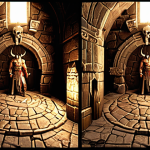Diablo 2, even after all these years, still throws us curveballs, doesn’t it? I swear, there’s nothing quite as frustrating as stepping into a pack of Oblivion Knights in Chaos Sanctuary or facing down those pesky Fire Enchanted uniques, only to watch your health melt away in seconds.
We’ve all been there, panicking as our character ignites, desperately chugging potions while the screen flashes red. It feels like the game itself is laughing at your pain!
For a game that’s seen countless guides and meta shifts, fire damage remains a persistent threat, demanding thoughtful strategies that the community continues to refine, even with newer iterations of similar games out there.
It’s not just about stacking fire resistance; it’s about understanding enemy patterns and optimizing your build for survival in the face of such overwhelming elemental onslaughts.
These timeless tactics are essential for anyone pushing into Hell difficulty. Let’s find out exactly how to extinguish those fiery threats.
Unraveling the Scorch: Understanding Diablo 2’s Fiery Threats

There’s a unique kind of dread that washes over you when your character is suddenly engulfed in flames, isn’t there? It’s not just about the damage numbers; it’s the panic, the frantic clicks, and the sudden realization that your meticulously crafted build might just melt away in seconds.
From my own countless deaths to Oblivion Knight hydras and Fire Enchanted elite packs, I’ve learned that truly surviving Diablo 2’s fire isn’t just about stacking resistance.
It’s about a deep understanding of *how* fire damage works in this game, down to its arcane mechanics, and knowing precisely which infernal creatures are most likely to send you back to town in a fiery blaze.
We’ve all seen those nasty little Fire Enchanted uniques explode on death, sometimes taking us with them, even when we thought we were safe. Or the relentless barrage from a pack of Burning Souls.
It’s truly a test of your resolve and knowledge.
The Mechanics of Melting: How Fire Damage Works
It might seem straightforward – fire damage burns you, right? But Diablo 2’s fire mechanics have nuances that can catch even seasoned players off guard.
You’ve got direct fire spells from monsters, like the Demon Lord’s Fireball or the Oblivion Knight’s dreaded Hydras, which deal immediate damage. Then there’s the subtle, insidious burn of “Fire Enchanted” monsters, especially those that explode upon death, dishing out a terrifying percentage of their *maximum* life as fire damage.
I can’t tell you how many times I’ve walked into a seemingly clear area, killed a unique, and then watched in horror as a delayed explosion vaporized my character.
It’s not always about the initial hit; sometimes, it’s the lingering effects or the unexpected burst. Understanding these different damage sources is the first step to survival.
It’s not just about a high number on your character sheet; it’s about anticipating the different ways fire can be applied and what type of resistance or strategy is best for each.
Identifying the Incinerators: Key Fire-Dealing Enemies
Knowing your enemy is half the battle, especially when they breathe fire. Certain monsters are infamous for their fire-based attacks, and learning their patterns is crucial.
Oblivion Knights in the Chaos Sanctuary are notorious for their Hydras, which can quickly fill a screen with deadly projectiles. Burning Souls, particularly in the Worldstone Keep, are spectral terrors that shoot relentless fire bolts, and their sheer numbers can overwhelm even maxed fire resistance.
And then, of course, there are the dreaded Fire Enchanted boss packs. I’ve seen countless Hardcore characters fall to a single unexpected explosion from one of these guys.
My personal rule of thumb? Always approach them with extreme caution, especially if they are surrounded by other monsters that might die first and trigger the chain reaction.
Understanding which monsters are the primary fire threats helps you prioritize targets and position yourself defensively.
Fortifying Your Defenses: Essential Gear & Setup
Okay, so you understand the fire now. But knowing isn’t doing. The next crucial step is shoring up your defenses.
We all know fire resistance is important, but there’s a world of difference between “having” fire resistance and “optimizing” it. It’s not just about hitting 75%; it’s about going beyond, about understanding the quirks of specific items, and knowing how to layer your protection effectively.
I’ve personally experimented with countless gear setups, and I can tell you, the difference between merely surviving and confidently strolling through a fire-heavy zone often comes down to those subtle gear choices and a bit of overcapping.
It’s about being prepared, not just hopeful.
Beyond Max Resistance: Overcapping for Survival
This is where the magic happens, and where many players, myself included early on, made crucial mistakes. In Hell difficulty, monsters can apply a “Conviction Aura” or “Lower Resist” curse, which *lowers* your resistances.
If you’re sitting exactly at 75% fire resistance, a single Conviction Aura Level 12 (common on Oblivion Knights) will drop your fire resistance by 85%, leaving you at a terrifying -10%!
This means you’re taking *more* fire damage, not less. Trust me, I learned this the hard way more than once. The solution?
Overcapping. Aim for fire resistance well above 75%, especially when venturing into high-danger zones like the Chaos Sanctuary or Worldstone Keep. Getting to 100%, 150%, or even 200% fire resistance means that even with resistance-lowering effects, you’ll still maintain a positive, damage-reducing number.
It’s a game-changer, plain and simple.
The Right Runewords and Unique Items for Fire Mitigation
Certain items are absolute lifesavers when facing fire. “Treachery” (Shael + Thul + Lem) is a fantastic low-cost armor runeword that grants 45% Fire Resist, but more importantly, it casts Fade, which gives you 60 All Resistances and 15% Physical Damage Reduction.
I’ve relied on this countless times! For shields, “Spirit” (Tal + Thul + Ort + Amn) offers a massive 35% All Resistances. Unique items like the “Hotspur” boots (45-50% Fire Resist) or the “Dwarf Star” ring (15 Fire Absorb, 40 Magic Resist) are incredibly potent.
Fire Absorb, in particular, is phenomenal; it not only negates fire damage but *heals* you for a portion of it. I remember the first time I equipped a Dwarf Star and saw my health bar actually *go up* when hit by a Hydra – pure bliss!
| Item Type | Recommended Item/Runeword | Key Fire Defense Stat(s) | Notes on Usage |
|---|---|---|---|
| Armor | Treachery (Shael+Thul+Lem) | 45% Fire Resist, Fade (60 All Resist, 15% DR) | Excellent budget option, Fade’s DR and resists are fantastic for survivability. |
| Shield | Spirit (Tal+Thul+Ort+Amn) | 35% All Resistances | Best-in-slot for many caster builds, provides crucial resists. |
| Boots | Hotspur | 45-50% Fire Resist | Great for hitting max Fire Resist, especially for new characters in Hell. |
| Ring | Dwarf Star | 15 Fire Absorb, 40 Magic Resist | Incredibly powerful against fire spells; literally heals you from fire damage. |
| Amulet | Mara’s Kaleidoscope | 20-30 All Resistances | High-end option for overall resistance boost. |
Strategic Combat: Movement, Positioning, and Evasion
Having the right gear is one thing, but knowing how to use it in the heat of battle is entirely another. I’ve seen players with perfect gear still get annihilated because they stood in the wrong place or didn’t react quickly enough.
Fire damage often comes in predictable patterns, and if you can learn to read those patterns, you can avoid a huge chunk of the incoming damage altogether.
This isn’t just about kiting; it’s about a deeper, almost intuitive understanding of enemy AI and projectile speeds. It’s a dance, really, and once you get the rhythm, the fiery threats become far less daunting.
Dodging the Inferno: Mastering Positional Play
Positioning is king against fire. For instance, Hydras from Oblivion Knights don’t track you after they’re cast; they land in a fixed spot. If you keep moving, you can often dodge every single fire bolt.
Similarly, when fighting groups with Fire Enchanted monsters, try to isolate them. If you can’t, kill the surrounding weaker monsters first, then retreat *far away* before the Fire Enchanted unique dies and explodes.
My rule of thumb is always to create distance or use obstacles like pillars or walls to break line of sight, especially against ranged fire attacks. I’ve sprinted around many a corner in Chaos Sanctuary, letting the walls absorb incoming hydra bolts, giving me precious time to regroup.
When to Engage, When to Retreat: Reading the Battlefield
There’s an emotional component to this game that a lot of guides miss: knowing when to bail. Sometimes, no amount of gear or skill will save you from an overwhelming fire-heavy pack, especially if you’re cursed or hit by Conviction.
If you see multiple Fire Enchanted monsters grouped with Oblivion Knights, and your health potion hotkey is getting a workout, it’s okay to run. Seriously, just open a Town Portal and rethink your strategy.
I’ve lived to fight another day countless times by simply saying “Nope!” to certain engagements and returning with a different approach or better preparations.
It’s not about being a coward; it’s about being smart and preserving your valuable experience and gear.
The Potion Panic & Beyond: Sustaining Your Health Pool
You know that moment, right? Your health bar is rapidly turning red, you’re chugging health potions like they’re going out of style, and you’re praying your character animation finishes before you hit zero.
It’s the “potion panic,” and it’s a rite of passage for every Diablo 2 player. While ideally you’d avoid getting hit by fire altogether, reality dictates that you *will* take damage.
So, having a robust system for health replenishment is absolutely critical. This isn’t just about carrying a belt full of potions; it’s about understanding when to use them, what types are most effective, and how other items can subtly but significantly contribute to your staying power against those relentless flames.
Optimal Potion Management in High-Pressure Situations
This might sound basic, but effective potion management is an art form. Don’t wait until your health is critically low to start chugging. Get into the habit of pre-potting or proactively using potions when you anticipate heavy incoming fire damage.
Keep your belt full of Super Health Potions and Full Rejuvenation Potions. Full Rejuvs are gold – they instantly restore health and mana, making them perfect for “oh crap” moments.
I always keep at least half a row of Full Rejuvs for emergencies. Also, remember that your mercenary can use potions from your belt too – dragging a potion onto their portrait can be a lifesaver for them, and consequently, for you!
Valuable Charms and Their Role in Survivability
Charms are silent heroes in your inventory. Beyond grand charms that boost skills, small charms with elemental resistances (especially fire) are incredibly potent.
Even a simple “Small Charm of Flame” (10-11% Fire Resist) can be the difference between life and death. Stack these up! Life charms are also invaluable.
Having a few small charms with +15-20 life scattered throughout your inventory can add hundreds of extra hit points, providing a larger buffer against burst fire damage.
I always prioritize these in my inventory, carefully arranging them to maximize space while boosting my defenses.
Leveraging Your Companion: The Mercenary’s Role in Fire Fights
Your mercenary isn’t just a meat shield; they’re a crucial part of your overall strategy, especially against elemental threats like fire. A well-equipped and strategically positioned mercenary can draw aggro, provide essential buffs, and even deal significant damage, all of which contribute to your survival.
I’ve relied on my Act 2 Holy Freeze merc more times than I can count to slow down those relentless packs of Burning Souls or to provide a buffer against a group of Oblivion Knights.
They might not always feel like they’re pulling their weight, but when properly geared and managed, they become indispensable allies in the fiery depths of Hell.
Equipping Your Merc for Maximum Fire Resistance Support
Your mercenary needs fire resistance too! Items like “Duriel’s Shell” (20 All Resistances, Cannot be Frozen) or “Treachery” (Fade, 45% Fire Resist) are excellent armor choices for mercs.
For weapons, an “Insight” runeword (Ral + Tir + Tal + Sol) provides a Meditation Aura, which grants passive mana regeneration, allowing you to cast more defensive or offensive spells without running out of resources.
I’ve found that keeping my merc alive with good gear, including specific fire resistance pieces, makes them far more effective at tanking fiery onslaughts, letting me focus on my own positioning and damage output.
Strategic Mercenary Placement and Abilities
Beyond gear, how you use your mercenary matters. For fire-heavy areas, if you have an Act 2 Holy Freeze merc, their aura will slow down fast-moving fire-dealers like Burning Souls, making them easier to avoid or hit.
If you’re encountering concentrated fire from Hydras, try to position your merc to draw some of that fire, giving you a window to counterattack or reposition.
They can also absorb exploding Fire Enchanted uniques if you lead them into the death animation first. It’s a risky maneuver, but one I’ve employed successfully when desperate.
Remember, they are extensions of your build, and their survival directly impacts yours.
Advanced Tactics: Countering Fire with Offensive Pressure
While defense is paramount, sometimes the best defense is a good offense, even against fire. This isn’t about ignoring fire resistance; it’s about understanding how to use your own damage and crowd control to mitigate incoming fire, particularly when facing monsters that are fire immune.
It’s a nuanced approach that combines your defensive preparations with smart targeting and aggressive, yet controlled, damage output. I’ve often found that quickly dispatching a handful of fire-dealing monsters can prevent far more damage than any amount of stacked resistance ever could.
Breaking Immunity and Delivering Devastating Blows
In Hell difficulty, many monsters are immune to certain damage types. Fire Immunes are common. If your main damage source is elemental, you’ll need a way to break their immunity or rely on your mercenary’s damage.
“Infinity” runeword (Ber + Mal + Ber + Ist) on a merc’s polearm provides a Conviction Aura that can break many elemental immunities, including fire. This is a high-end solution, but incredibly effective.
If Infinity isn’t an option, consider carrying a secondary damage type weapon or relying on physical damage from your merc. Prioritizing targets is key: eliminate the fire-immune monsters quickly if they are also fire-dealers, or simply bypass them if they pose no threat.
Recognizing Vulnerabilities and Exploiting Them
Even the most terrifying fire-slinging monsters often have other vulnerabilities. Oblivion Knights, for example, while deadly with fire, aren’t particularly tanky in terms of health.
If you can get past their initial Hydra barrage, you can often burst them down quickly with high single-target damage. Burning Souls, while numerous and annoying, have low health and can be dispatched rapidly with area-of-effect attacks.
It’s about identifying the weakest link in their defenses and exploiting it. Don’t let their fire intimidate you into inaction; sometimes, a swift, decisive strike is the best way to extinguish the threat.
Concluding Thoughts
So, you’ve journeyed through the fiery depths with me. Mastering fire in Diablo 2 isn’t about a single magic item or one perfect stat; it’s a symphony of understanding game mechanics, optimizing your gear for specific threats, and adapting your strategy on the fly.
It’s about respecting the inferno, but never fearing it. With the right preparation and a bit of battlefield savvy, those once-dreaded flames will become just another obstacle you confidently stride through, leaving nothing but scorched earth in your wake.
Stay safe, adventurer, and may your resistances always be capped!
Useful Information to Know
1.
Always overcap your Fire Resistance, especially in Hell difficulty, to counter resistance-lowering curses and auras.
2.
Prioritize specific fire-absorbing or high-fire-resistance unique items like Dwarf Star and Hotspur when facing heavy fire.
3.
Learn enemy attack patterns, particularly Hydras and Burning Souls, to master positional play and dodge incoming projectiles.
4.
Keep a supply of Full Rejuvenation Potions for instant health and mana recovery in critical situations.
5.
Invest in your mercenary’s gear and positioning; they can be invaluable for drawing aggro and providing crucial auras.
Key Takeaways
To conquer Diablo 2’s fiery threats: overcap resistances significantly, understand monster attack mechanics and vulnerabilities, master defensive positioning, effectively manage potions, and properly equip and utilize your mercenary.
Frequently Asked Questions (FAQ) 📖
Q: Facing those specific fire threats like Oblivion Knights or Fire Enchanted uniques, it feels like I just melt. What’s the real trick to not instantly dying, especially when they hit like a truck?
A: Oh, tell me about it! I swear, those Oblivion Knights in Chaos Sanctuary and those Fire Enchanted uniques are the absolute bane of my existence sometimes.
My trick, after countless fiery deaths, is less about raw resistance and more about tactical evasion and damage mitigation. First, always keep your eye out for their aura or the tell-tale glow of a Fire Enchanted boss.
The moment you see it, pre-emptively pop a Full Rejuvenation Potion if things are about to get hairy, or even better, before you engage. For Oblivion Knights, it’s not just their fire bolts but their ‘Decrepify’ curse that’s the real killer, slowing you down and making you even more vulnerable.
So, if you’re a teleporting character, you have to be constantly repositioning, hitting and running. For melee, it’s about hit-and-run tactics, or if you’re tanky enough, just tanking it and relying on massive life leech or crushing blow to take them down fast.
My experience says that if you stand still for even a second against a beefed-up Fire Enchanted unique, you’re done for. It’s all about not letting them hit you with their death explosion, which is where many fall.
Move away immediately after they die! Seriously, I’ve lost so much hard-earned gold because I wasn’t quick enough.
Q: So, it’s not just about stacking Fire Resistance. What are some of those ‘thoughtful strategies’ that truly make a difference against overwhelming fire damage, beyond just gear?
A: You hit the nail on the head! Just maxing out your Fire Resistance to 75% or even 95% with FHR (Faster Hit Recovery) isn’t always enough, especially in Hell.
I’ve learned this the hard way: it’s about how your stats interact. One key ‘thoughtful strategy’ is understanding that while resistance reduces the percentage of damage, raw life and defense reduce the impact.
So, make sure you’re hitting your Faster Hit Recovery breakpoints. Nothing’s worse than getting stun-locked by a flurry of fireballs while your health melts.
Another huge one is Damage Reduced by X (DR) and Magic Damage Reduced by X (MDR). These stats actually shave off a flat amount of damage before resistances are even calculated, which can be a lifesaesaver against rapid-fire projectiles like those from Oblivion Knights.
I’ve seen countless characters just faceplant because they focused solely on resistances when a little physical damage reduction or magical damage reduction would have saved them.
And seriously, don’t underestimate the power of a good mercenary. An Act 2 Holy Freeze merc can slow down those fiery threats, giving you precious seconds to react or reposition.
It’s not just about your character; it’s about your whole party’s synergy.
Q: When I’m pushing into Hell difficulty, what build optimizations, beyond just gear, should I really be looking at to make sure I’m not incinerated by every fiery mob I encounter?
A: This is where the rubber meets the road, isn’t it? Hell difficulty is brutal, and fire is everywhere. Beyond just getting your resistance up, my personal optimization philosophy revolves around two things: maximizing my survivability while maintaining damage output, and ensuring my character can escape or counter-attack effectively.
For example, as a Sorceress, it’s not enough to just dump points into your main skill. You absolutely need at least one point in Teleport, obviously, but also consider Energy Shield if you’re a mana-heavy build, as it can absorb a huge chunk of elemental damage.
For melee characters, a decent amount of points in Vitality is paramount; you can’t leech life if you’re dead. Also, looking at your skill tree for any skills that grant defensive buffs or temporary invulnerability is key – like Paladin’s Holy Shield or Barbarian’s Shout.
It’s a balancing act, truly. I’ve tweaked so many builds over the years, and I’ve found that having a ‘panic button’ skill or enough Life/Mana Steal (for physical attackers) to quickly replenish your resources is often more important than just an extra few points in your main attacking skill.
Don’t forget your charms! Carrying a few resistance charms, especially fire, can shore up any weak points in your gear without sacrificing major attributes, and I always keep a few Rejuvenation Potions readily available on my belt, not just in my inventory.
They’ve saved my bacon more times than I can count.
📚 References
Wikipedia Encyclopedia
구글 검색 결과
구글 검색 결과
구글 검색 결과
구글 검색 결과
구글 검색 결과



